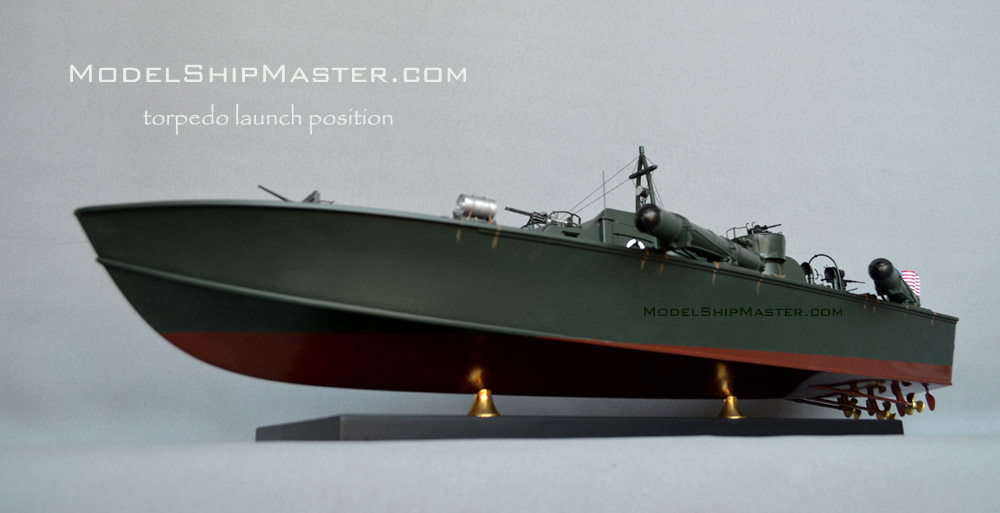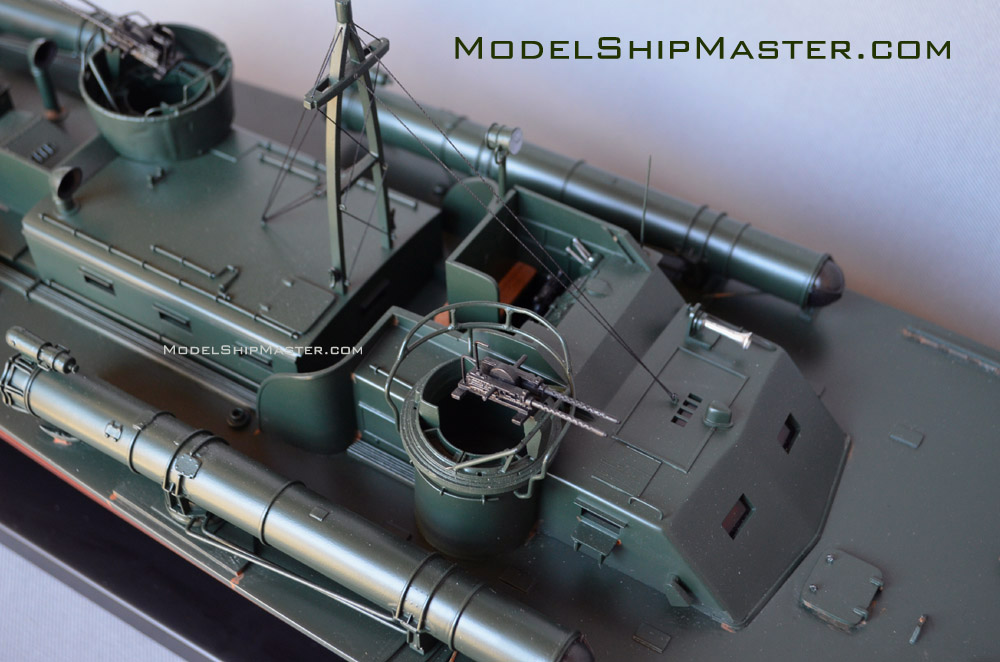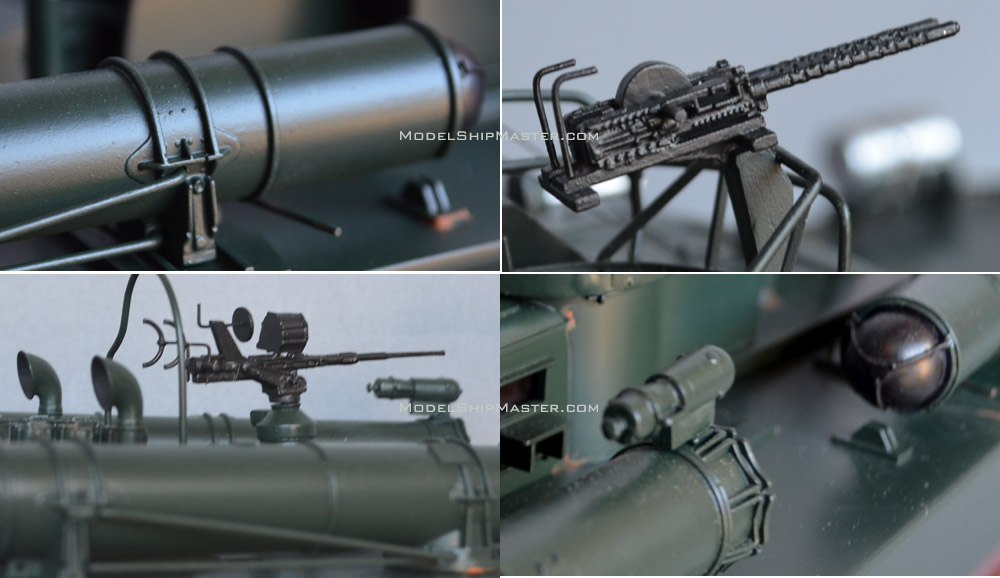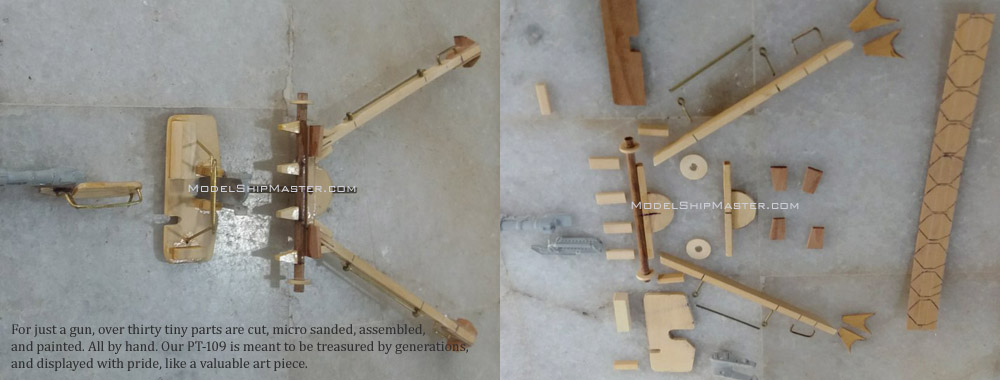|
PT-109 model
PT-109 was a patrol
torpedo boat commanded by Lieutenant John F. Kennedy in
World War II. Her keel was laid on March 4, 1942. At the Brooklyn Navy Yard,
she was fitted
out for war with four 21" torpedo tubes carrying Mark
VIII. Unlike most of her sister boats,
this PT boat carried two dept charges, one on each side.
Initially intended for possible use against submarines,
these depth charges were later used to deter destroyers
in pursuit.

.jpg)
On April 23, 1943, John
F. Kennedy was given command of the PT-109.
Patrolling the Solomon Islands was tough. The warm
water caused rapid growth and buildup of marine life on
the hull. This reduced the speed to below 36
knots, less than the top speed of the Japanese cruiser
and destroyers that protected Japanese supply barges
which were the main target of PT boats.
Very dangerously, the PT
boats had to get within two miles of its targets, and
mostly at night. That was well within the gun
range of enemy ships. On top of that, PT
boats used aviation gasoline that could destroy the whole boat if the engine compartment was
hit. The black powder charge that fired the
well-greased torpedoes could cause the grease to
ignite upon firing, giving out a flash and smoke that
could easily reveal the boat's position. Small
size, darkness, and maneuverability were their survival
tools.

On August 1st, PT-109 and
14 other boats were sent to sink a group of five enemy
destroyers. The attacking squadron were ready to
kill, but some of the 60 torpedoes exploded prematurely
and not a single hit was achieved. All boats then were
ordered back to base except PT-109, PT-162, and PT-169.
They were to patrol the area.
It was a very dark and
quiet night on the 2nd of August. The PT-109 was
going at very low speed with only one engine to minimize
the wake which might be detected by Japanese patrol
aircrafts. Suddenly the crew realized they were
right in front of an destroyer.
The destroyer Amagiri bore
down on PT-109 at a very high speed. No time to
get her engines up to speed, the torpedo boat was cut in half and
in flames.
Although well within
firing distance, PT-169's torpedoes missed the Amagiri
and PT-162's failed. Seeing the extent of the
damage and fireball from PT-109, the other two PT boats
returned to base without daring to stay and check for
survivors.
PT-109 was indeed fatally
damaged. Raging flames surrounded the forward
hull. Miraculously, only two crew members were
killed, and only two others were badly injured.
Using timber, life jackets
and other parts lashed together, the seamen kicked for
four hrs thru shark infested waters and reached a tiny
island 3.5 miles away. They then moved to another
island and survived on coconuts. Hiding for six
days, and with the help of the local, they were able to
send their location information to the nearest base 35
miles away and finally were picked up by a PT.
Though Kennedy
emerged as a hero (awarded the Navy and Marine Corps
Medal), a few in the military including general Douglas
MacArthur thought he should have faced a
court-martial for losing his boat in such
circumstance: such a quick and
maneuverable craft should have been able to avoid
being rammed by a much slower enemy vessel.
In May 2002, a National
Geographic expedition
found wreckage matching the description and location
of Kennedy's vessel in the Solomon Islands.
However, under current Navy policy, the wreckage
site is a gravesite and may not be disturbed.

This
primarily wood PT-109 model is 28" L x
9.5" T x 7.5" W $3,490
 shipping
and insurance in the USA included,
Other places: $300 flat rate.
This model is in stock and can be shipped within 5
business days.
shipping
and insurance in the USA included,
Other places: $300 flat rate.
This model is in stock and can be shipped within 5
business days.
.jpg)

Learn more about the PT-109 model here:
https://en.wikipedia.org/wiki/Patrol_torpedo_boat_PT-109
|